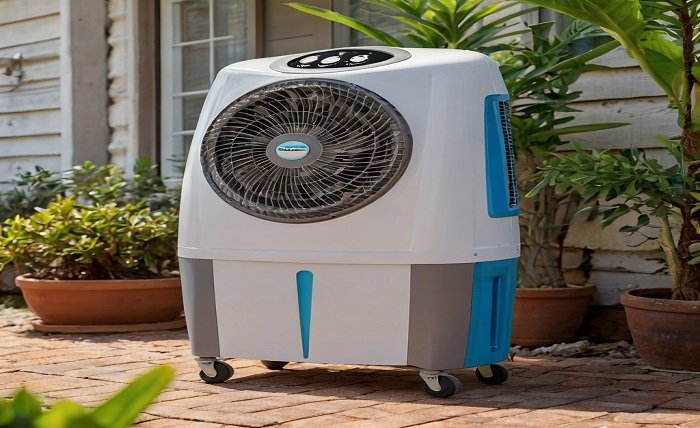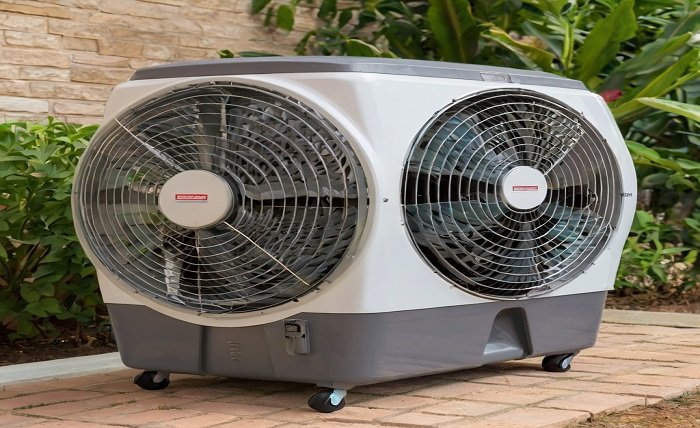Swamp coolers, sometimes called evaporative coolers, are a type of energy-efficient cooling option that is becoming more and more popular. Evaporative coolers, as opposed to conventional air conditioners, chill the air through the evaporation process. Many homes and businesses favor this approach because it is not only economical but also ecologically benign. yeticooler
Functions of Evaporative Coolers

Evaporative coolers operate on a straightforward but efficient basis. When heated air passes over water-saturated pads, evaporation occurs and the water absorbs the heat, producing cool air. Moving this air around the room subsequently creates a cool breeze. Since the air can absorb more moisture in dry climates, evaporative coolers perform best in environments with lower humidity levels. technewztop
Evaporative cooler advantages
Comparing evaporative coolers to conventional air conditioning systems reveals many advantages. First of all, they use up to 75% less electricity, making them extremely energy-efficient. As a result, your energy bills will significantly decrease. Furthermore, evaporative coolers are an environmentally responsible choice because they don’t use hazardous refrigerants. By removing dust and allergens, they help enhance indoor air quality, resulting in a healthier living space.
Evaporative Cooler Types
On the market, numerous varieties of evaporative coolers are appropriate for various purposes. The most typical kinds consist of:
Portable evaporative coolers: These are lightweight and portable, making them perfect for tiny places.
Window Evaporative Coolers: Installed in windows, these coolers are perfect for cooling specific rooms.
Whole-House Evaporative Coolers: These units, typically mounted on an external wall or roof, can cool entire houses.
Air conditioners versus evaporative coolers
There are a few things to consider when contrasting evaporative coolers and conventional air conditioners. Air conditioners are more expensive to operate and maintain, even if they offer perfect temperature control. Conversely, evaporative coolers are less expensive and more ecologically friendly, although they might not work as well in humid conditions. Understanding the differences can help you determine which cooling system best suits your needs.
Choosing an appropriate evaporative cooler
The size of the area, the temperature, and the particular cooling requirements are just a few of the variables to take into account when choosing the ideal evaporative” cooler. Selecting a type that has the right amount of cooling power (calculated in cubic feet per minute, or CFM) for your area is crucial. Adding features like air filtration, remote control, and variable speed settings can enhance the cooler’s use and convenience.
Top Evaporative Cooler Models
Numerous evaporative” coolers are available on the market, each with special characteristics and advantages. Some of the best models include:
The Honeywell CO48PM: is well-known for its sizable water tank and strong cooling.
Hessaire MC37M: well-liked for its efficiency and portability.
The Portacool Cyclone 140: large cooling capacity makes it perfect for outdoor areas.
Tips for Evaporative Cooler Maintenance
It is critical to maintain your evaporative” cooler’s longevity and optimal functioning. Regular cleaning of the water tank, pads, and filters can prevent the accumulation of minerals and mold. It’s also critical to frequently inspect the water pump and motor and replace the cooling pads as needed. Maintaining your cooler properly will guarantee that it runs smoothly and consistently cools. post-officehours
Typical problems and solutions
Even though evaporative” coolers are usually reliable, they may have problems, including decreased cooling effectiveness, water leaks, and odd noises. Worn-out parts, low water levels, or blocked pads frequently cause these issues. You must inspect and clean the cooler, ensure a sufficient water supply, and replace any damaged parts to resolve these issues.
The Future of Evaporative Coolers
Evaporative coolers should have a bright future because of how effective and efficient they are becoming as technology develops. Modern advancements, including intelligent controls, solar-powered variations, and enhanced materials for the cooling pad, are increasing the adaptability and user-friendliness of evaporative” coolers. As the need for environmentally friendly and low-energy cooling options increases, evaporative” coolers will probably gain even more traction.
In summary
Evaporative coolers provide a productive, economical, and eco-friendly means of cooling your house or place of business. Understanding how they operate, their advantages, and their maintenance can help you make an informed choice about adding this cooling solution to your area. Evaporative” coolers offer a practical and environmentally friendly way to stay cool, regardless of your goals—whether it’s lower energy costs or better indoor air quality. modern-mullet
FAQ
In humid climates, are evaporative” coolers effective? Dry environments are the best for evaporative” coolers. In humid situations, their cooling efficiency drops because the air can’t hold as much moisture.
How often should I clean my evaporative” cooler? We recommend cleaning your evaporative” cooler at least once a month during the cooling season. Sufficient upkeep guarantees maximum efficiency and durability.
Is it okay to operate an evaporative” cooler with closed windows? No, evaporative” coolers require an open window or door to maintain adequate ventilation and release humid air.
How much water do evaporative” coolers use? Evaporative” coolers use water, but the amount varies depending on the model and use. They use between three and fifteen gallons of water a day on average.
How can I pick the ideal evaporative” cooler size for my area? To select the appropriate size, determine the amount of space (in square feet) and search for a cooler whose CFM rating equals or exceeds this figure. Generally, we advise 20 to 40 CFM per square foot.

